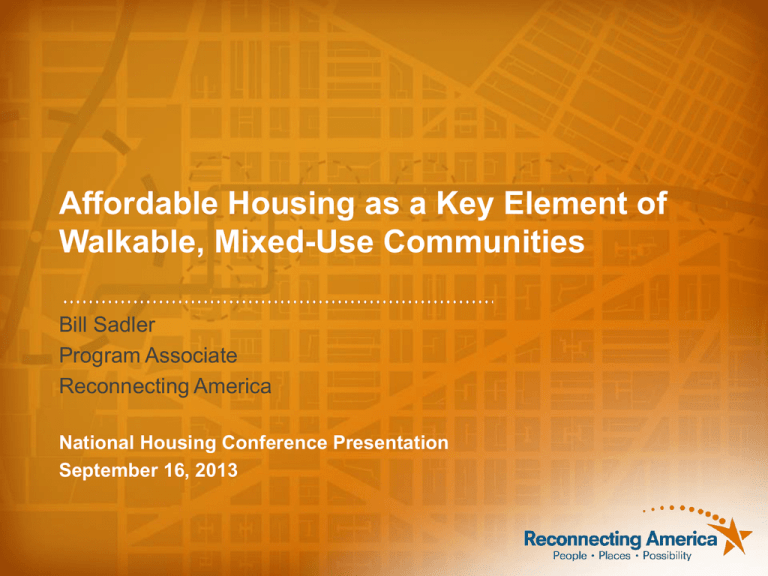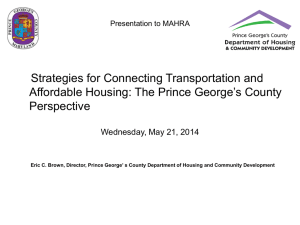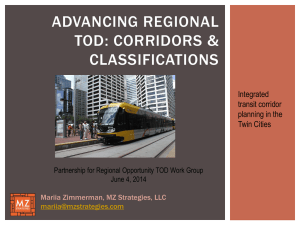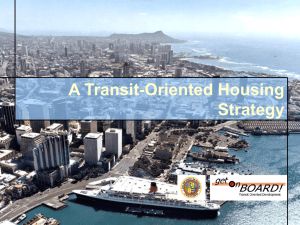Affordable Housing as a Key Element of Walkable, Mixed-use
advertisement

Affordable Housing as a Key Element of Walkable, Mixed-Use Communities Bill Sadler Program Associate Reconnecting America National Housing Conference Presentation September 16, 2013 Presentation Overview • What are the Benefits of Affordable Housing in Walkable, Mixed Use Communities? • Case Studies & Strategies to Promote Affordable Housing Near transit • Atlanta Typology Case Study 2 © 2010 Reconnecting America. Who is Reconnecting America? • Reconnecting America is a national nonprofit that advises civic and community leaders on how to overcome community development challenges to create better communities for all. • Reconnecting America develops research and innovative public policy, while also building onthe-ground partnerships and convening players needed to accelerate decision-making. 3 © 2013 Reconnecting America. Reconnecting America • Technical Assistance: Creating a national marketplace for TOD, working with cities, transit agencies, developers, investors + communities • Policy: Improving practice through technical assistance, research + policy reform • Education: On-line Clearinghouse of TOD + Transit Best Practices 4 © 2013 Reconnecting America. CTOD Partnership Dedicated to providing best practices, research and tools to support market-based transit-oriented development • TOD 101 and 200 series booklets : www.ctod.org • National TOD Database: www.toddata.cnt.org • Mixed-Income Housing Action Guide: www.mitod.org • Online Resource Library: http://www.reconnectingamerica.org/resourcecenter/ 5 © 2013 Reconnecting America. Walkable Communities & Transit-Oriented Development (TOD) TOD is type of community development that includes a mixture of housing, office, retail and/or other amenities integrated into a walkable neighborhood and located within a half-mile of quality public transportation. At Reconnecting America, we believe it is essential that TOD creates better access to jobs, housing and opportunity for people of all ages and incomes. Successful TOD provides people from all walks of life with convenient, affordable and active lifestyles and create places where our children can play and our parents can grow old comfortably. 6 © 2010 Reconnecting America. What Has Motivated Places to Embrace Walkable Communities & TOD? • Economic Competitiveness • Congestion Relief • Air Quality and Public Health • Managing Growth • Focusing Investment – Stimulating Revitalization 7 © 2013 Reconnecting America. The Benefits of TOD Overlap with Benefits of Mixed-Income Neighborhoods 8 © 2013 Reconnecting America. Who Lives and Works Near Transit? Transit Served Areas: • Home to nearly 1//2 of the country’s residents • More than 70 percent of the workforce • Over half the Black population • Over 60% of the Hispanic population • Over 70% of the nation’s immigrants • Slightly over half of the nation’s rental housing Source: Dukakis Center for Urban and Regional Policy (Maintaining Diversity in America’s Transit-Rich Neighborhoods) 9 © 2013 Reconnecting America. Demand is Increasing… By 2030: • More than half of potential demand for housing near transit centers will come from households with below median incomes • Households sizes are decreasing • Demographic groups growing more quickly – older, nonfamily, non-white households – use transit more • The housing stock will need to be more diverse and affordable 10 © 2013 Reconnecting America. …and the stock is decreasing Project-based Section 8 Project-based Section 8 and 202 Housing and 202 Housing • 250,000 affordable 250,000 apartments within ½ mile of transit • Approximately 70% have contracts that will expire by 2014. Source: Preserving Affordability and Access in Livable Communities, AARP, National Housing Trust and Reconnecting 11 © 2013 Reconnecting America. Potentially at Risk Housing 31% 69% Challenges with Building Affordable Housing Near Transit and/or Walkable Communities Complexity of building mixedincome projects High land costs near transit 12 © 2013 Reconnecting America. Achieving revitalization without displacement Addressing housing preservation needs Lack of Integration in housing, land use and transportation planning How Do We Ensure That Everyone Benefits from Walkable Communities? Lower VMT/ Higher Ridership Density Block size Greater Equity Outcomes Affordability Inclusiveness Places People Equitable Communities Lessons Learned From the Data: The “Sweet Spot” For Equitable Communities Lower VMT/ Higher Ridership Places Greater Equity Outcomes CORE TRANSIT RIDERS People The Mixed-Income TOD Action Guide Website Available at: www.mitod.org • A tool for local jurisdictions working to foster mixedincome transit-oriented development (TOD) around planned transit stations. • Acquire an invaluable set of data that describes the demographics and marketpotential of the transit district of interest, • For more information go to www.mitod.org 15 © 2013 Reconnecting America. Strategy 1: Build Your Case. Use data to make the case • Set the stage for the importance of integrating affordable housing Challenges • Lack of funds • Outside of organization’s mission (transit agencies) • Lack of internal and board support • Lack of political support 16 © 2013 Reconnecting America. Increased fare revenue Stabilized ridership Transit Agency Reduced public subsidies The Denver Regional Equity Atlas Jobs Affordable Housing Strategy 2: Provide Incentives and Remove Regulatory Barriers • Retool zoning and financial incentives to meet goals • Encourage a mix of uses integrate housing and other uses • Tools: • • • • 18 Inclusionary Zoning Density bonus Streamline application Reduce Permit fees © 2013 Reconnecting America. Strategy 3: Preservation of Existing Housing Stock • Make an affordable housing inventory • Identify acquisition resources • Denver TOD fund • Ensure that sufficient federal funding exists to renew all expiring contracts • Develop early warning systems to track-at-risk housing and allocate resources appropriately • 19 Engage with transit planners to identify common goals © 2013 Reconnecting America. R Street Apartments, DC: NHT and Enterprise affordable housing preservation Strategy 4: Coordinate Investments Near Transit • Encourage public/private investment in walkable neighborhoods near transits • Fund and prioritize housing investments across the region • Investments in development around transit create value that can be captured and reinvested in the community • Tax-Increment Financing • Joint Development • Special Assessment Districts 20 © 2013 Reconnecting America. Bay Area Transit-Oriented Affordable Housing Fund (TOAH) Bay Area TOAH • $50 million for affordable housing near transit (and community facilities and other neighborhood uses) • Nine-county Bay Area • Includes $10 million investment from the Metropolitan Transportation Commission • Managed by the Low Income Investment Fund (LIFF) and other partners 21 © 2013 Reconnecting America. Strategy 5: Policy Support at the Federal Regional and Local Levels Federal Policy and Funding State Policy & Enabling Authority, Funding, and Institutional Framework Regional Planning and Investments Local Policy and Implementation Tools 22 © 2013 Reconnecting America. Strategy 6: Proactively Plan for Station Areas • Brings all stakeholders together • Can be done at local, state and regional (corridor) level • Sets the long-term vision and implementation steps • Identifies needs and opportunities • Assess market for types of strategies and tools • Creation or preservation strategies 23 © 2013 Reconnecting America. The Atlanta TOD Typology (in process) • Tell the story about the Atlanta transit system and its communities • Identify vulnerable stations for displacement and needs for affordable housing • Understand TOD interventions needed for equitable TOD • Catalyze TOD in sites with the most potential for successful TOD • Identify where & what type of infrastructure improvements are needed 24 © 2013 Reconnecting America. Market & Vulnerability Together Typology Map 25 © 2010 Reconnecting America. Categorizing Stations into Place Types: Equity Lens and Market Matchup 26 © 2010 Reconnecting America. Place Types 27 © 2010 Reconnecting America. Where Do Workers Live? Low Wage Saturation ( < $15K / Year) Residential Location 28 © 2010 Reconnecting America. Where Do Workers Live? Moderate Wage Saturation ($15K - $40K / Year) 29 © 2010 Reconnecting America. Where Do Workers Live? High Wage Saturation (> $40K / Year) 30 © 2010 Reconnecting America. Housing Units Affordable at 50% AMI Family of 4 Making Less than $35,900/Yr 31 © 2010 Reconnecting America. Housing Affordable at 80% AMI Family of 4 Making Less Than $57,450 32 © 2010 Reconnecting America. Thank you! Bill Sadler Program Associate Reconnecting America EMAIL: bsadler@reconnectingamerica.org PHONE: 303.830.0071 Visit us at www.ReconnectingAmerica.org Find us on Facebook Linked In Twitter YouTube Flickr @reconnecting reconnectingamerica ractod







